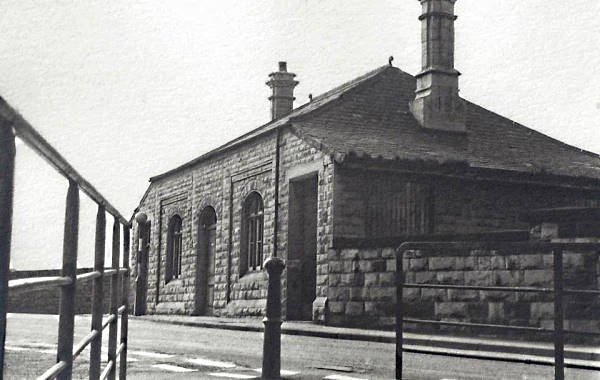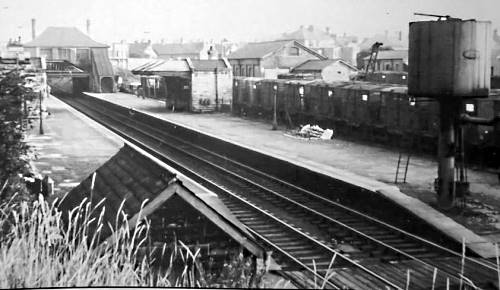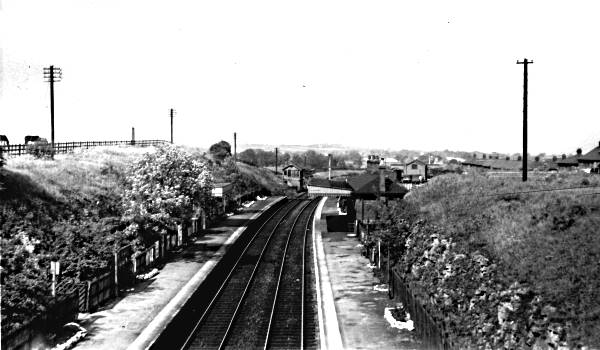A Hucknall History
Transport Back to the Future
Tracked Train Stations
Britain's industrious 19th century saw maturing years of steam engined vehicles. A revolutionary power capable of breaking all land speed records removed limiting factors for heavier and distant transportation. Competitive railroads soon began networking industrial cargoes before extending pleasurable passenger journeys. Fuelling this marvel mechanisation drove Nottinghamshire pits to reach deeper depths, and it was winning those important coals which attracted private rail group investors. Seeking out such profitable cargo routes, they'd find little resistance laying lines through towns with the lure of adding branched passenger stations.

Powerful amalgamations ultimately formed a larger Midland Railway
on 10th May 1844. Planned rail roads radiating from a Nottingham central hub dates 2nd October 1848 opening of their passenger lines into Kirkby. Having purchased the old Mansfield and Pinxton tramway for £21,066 in 1847, modifications converted its future role under heavier steam trains. Next heading east from Kirkby the MR company thus extended passenger services on into Mansfield by October 1849.
Rapidly networking broader industrial markets became beneficial for businesses all wishing to share futuristic advancements. The general public desired simpler pleasure, to ride in comfort on the fastest affordable regular passenger services.
Sutton Junction
Everywhere then seemed eager to promote importance boasting its own station. Sutton-in-Ashfield was no exception. The Midland railway dutifully added a ticket office platform on the Mansfield junction lines crossing its borders from Nottingham. Alongside the old Adlington Mill at farther end a Forest Lane, this passenger platform named Sutton Junction opened 9th October 1849. Railway carriage journeys were thus grandly welcomed within that shared parish, although it was remotely sited from the populated core.

Huthwaite may have shared interest using this nearest station, if also affording about a 3 mile carrier cart connection. Even the townspeople soon realised it was a little too far away to walk.



Sutton Town
To better serve general public requirements within that busier parish town centre, a second platform was next built in closer walking distance. Costing £52,448 the Midland Railway added a branch line from its existing Sutton Junction. following lengthy extension of Forest Road, later renamed Station Road from this second station upon Clarkes Croft, once sited nearer todays High Pavement.


Photo dates 1st May 1893 occasion when ceremoniously opening this Midland Railways Town Station. Proud presence of members to the Local Board were among those officially invited aboard a supplied saloon to formally take that first run.


Popularity of this Town Station far exceeded designed purpose. Simply providing a short shuttle service ride along a branch line to the main Sutton Junction station, was apparently where passengers then needed to reboard mainline train carriages to journey onward. Nonetheless, just a quick seated trip behind this engine called Emma only cost a penny. So the affordable novelty of taking that short shuttle ride became a regular treat enjoyed by many youngsters fondly long recalling that little Penny Emma train.

The success of this line is suggested by a Mansfield 1897 press report, which relates a number of passengers were complaining of peak time overcrowding on that single Nottingham line. Another company track was, however, already progressing.
Great Northern

The Great Northern Railway laid its own lines from Nottingham. Heading northward into Shirebrook carved a railroad directly through Sutton-in-Ashfield beneath the bridged Outram Street. Their Great Northern station was opened 1st March 1898 for goods. And without any known prompting or delay, passenger services were opened 4th April. Significance of that occasion was marked by a Town Hall banquet arranged by Mr AH Bonsor JP. Claiming greatly honoured attendance were several hundred tradesmen, manufacturers and gentlemen.
Photo interestingly shows when it displayed two platform signs. Top reads SUTTON-IN-ASHFIELD, below it FOR HUTHWAITE, possibly before likewise updating the 1908 Town sign. This fast emerging individual township was thus invited to share either competitively placed town railroad stations. And despite a closer village Whiteborough Station, electric trams plus easier road haulage more favoured both CWS deliveries and passengers.







A 1903 leaflet simply helps demonstrate one major change in lifestyles resulting from steam trains. Just a day trip for kids to our nearest seaside? Skegness has the nearest beach about 80 miles away by road, and thereafter became the most popular family holiday destination from our Midlands region. Journeys casually taken now are by train, bus, car and motorcycle. But a day return visit could hardly have been imagined possible before harnessing the powers of steam. And these comfortably roomy carriages could even seat a boatload of passengers.
In comparison to a stage coach on best prepared routes, they could average 7mph by changing a 4 horse team around every 6 miles. So this coastal journey would have required some 15 stops using 60 horses. Sat inside a small carriage with no time for rest, it could possibly have been achieved within 12 hours. Maybe trying it explains why seaside hats displayed 'kiss me quick'. After such a hectic trip to find the tide out, there would be little time left reaching the sea for a quick paddle before jumping back aboard and repeating an exhausting return home same day.
Charging 1d per mile would've seemed a very reasonable fare. Yet adult returns on that Great Northern Railway were just 2 shillings 9 pennies and children under 12 even rode half price. This afforded group day trips, plus a whole family to begin enjoying pleasurable voyages, staying on longer invigorating seaside holidays.
These three town stations were only a few miles walk or short carrier ride away from Huthwaite. Two mainlines broadened variety of destinations and competitively encouraged pleasurable leisure and business commutes. Nevertheless, a village unable to boast its own station would then seem too insignificant. Opening a Woodend Station to serve an individually prospering township thus all seemed well and good, until realising it became easier to reach busier Sutton stations. For that reason, mention is given a fourth Sutton Station, thirdly sited upon Station Road.
Great Central
Mansfield Railway opened a 1917 Sutton-in-Ashfield Central station on their competitively laid line between Mansfield Central and Kirkby-in-Ashfield Central stations that would regularly run to Nottingham Victoria. A 1921 Railways Act affecting independent companies efficiently grouped into a big four, might recognise this Great Central Railway before next super sizing a 1923 LNER.


British Railways 1948 takeover closed all regular services from Sutton Central Station 3rd January 1956. Some weekend summer excursions continued though. Favouring more Lincolnshire beeches next to Skegness adds further destinations, explaining how my grandparents alternatively sought Cleethorpes until about 1962. Losing almost all 1923 networks simplifies modern EMR railroads.

01 Jan 04 by Gary Elliott Updated 19 Feb 23
